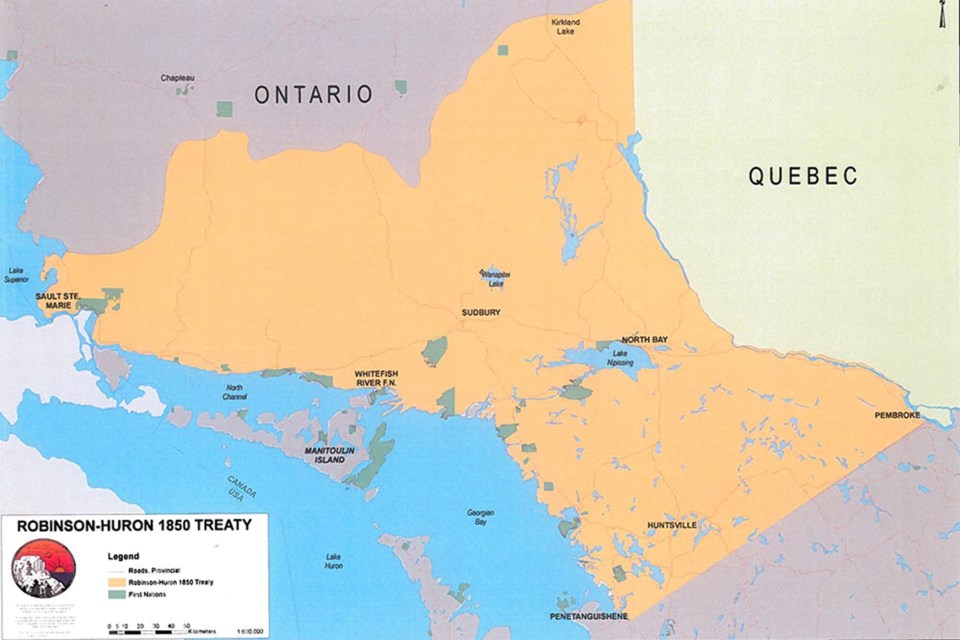While the monies for past compensation have been partially distributed, there are still negotiations left for the future, and the Robinson Huron Treaty Litigation Fund team is calling on the government, “urging them to begin work immediately” with go-forward negotiations.
The chiefs and trustees of the Robinson Huron Treaty Litigation Fund (RHTLF) met for two days on Oct. 16-17, to formulate a plan for the implementation of the Treaty Augmentation Promise going forward, states a release from the team.
The Litigation Management Committee of the RHTLF state they issued letters in August to Indigenous Affairs Minister Greg Rickford and to the federal minister of Crown-Indigenous Relations, Gary Anandasangaree, urging them to begin work immediately on establishing the Council Fire.
To date, neither Canada nor Ontario has responded to those letters.
Formed in 2010, the RHTLF was created to pursue an increase to an annuity that Anishnaabe signatories are entitled to under the Treaty of 1850. After filing a claim against the Crown, stating Canada and Ontario were not living up to a clause that would increase annual payments as wealth was generated from the land, court hearings resulted in a $10 billion settlement. Signatory First Nations are now working to distribute those funds to their members on a per capita basis.
Those negotiations covered what the courts and settlement the monies owed between 1874 and 2024, and now, the signatories are pushing to learn what the government has in mind for the yearly a cheque that still sits at $4.
The Supreme Court of Canada in the Restoule decision, released on July 26, called the failure of the Crown to augment the Treaty for well over a century a “longstanding and egregious” breach, which “severely undermined both the spirit and substance of the Robinson Treaties.”
In the Restoule decision, the Supreme Court also held that the treaties represent the “establishment of a relationship of trust and mutual assistance”, the details of which “must be the object of permanent negotiations, in view of fleshing out the general principles governing the relations between the two peoples”. The Court directs “that Ontario and Canada must act now to respect their treaty promises to the Anishinaabe, and to help restore the honour of the Crown and the nation-to-nation alliance that the treaties represent.”
The Court goes on to mandate that “It is time for the parties to return to the council fire and rekindle the perpetual relationship that the Robinson Treaties envision. Nothing less will demonstrate the Crown’s commitment to reconciliation.”
At their meeting Oct. 16-17 on Manitoulin Island, the chiefs and trustees also reaffirmed their commitment to Treaty renewal and again called upon Ontario and Canada to abide by the directives of the Supreme Court.
To prepare for the go-forward negotiations, release states the Chiefs and Trustees also committed to undertake their own internal Council Fire and Ceremonies to ensure that the leadership is “speaking with one heart”, according to Anishinaabe law and as instructed by the Elders.
A joint statement from the Trustees and Chiefs reads:
“The Anishinaabek of the RHT territory and the Crown collectively hold a perpetual responsibility and commitment to ensuring that the lands, resources of the Robinson Huron Treaty territory and the relationships with all beings is fully respected. For the Anishinaabek, we must ensure that our treaty continues to reflect the will of our Creator and Ancestors. We must also ensure that when we collectively make decisions, it is done in the manner inclusive of our Anishinaabe Laws and ceremonies.”
“We start with a Council Fire. Since the beginning of time, that is how our people discussed and decided major issues impacting the Anishinaabek – such as treaty relationships and agreements. Council Fires remind and teach us about our responsibilities to one another and those that came to live amongst us. Council Fire is how we enter negotiations on treaties. Council Fire not only brings people together around it, but also everything within it and used around it, is significant in how the
Anishinaabek decide and commitments on behalf of our people. The wood and sticks used in the fire, the pipe and medicines shared amongst each other and the smoke from Fire, Pipe and Sacred Medicines elevate to the Creator. This is our Anishinaabe Law making ways.”
Jenny Lamothe covers vulnerable and marginalized populations for Sudbury.com.
